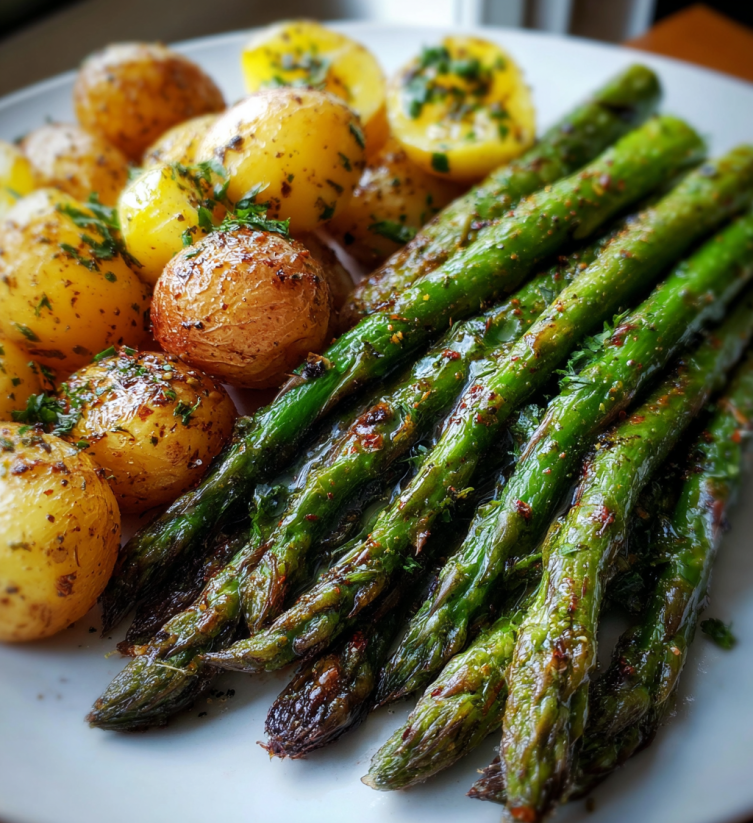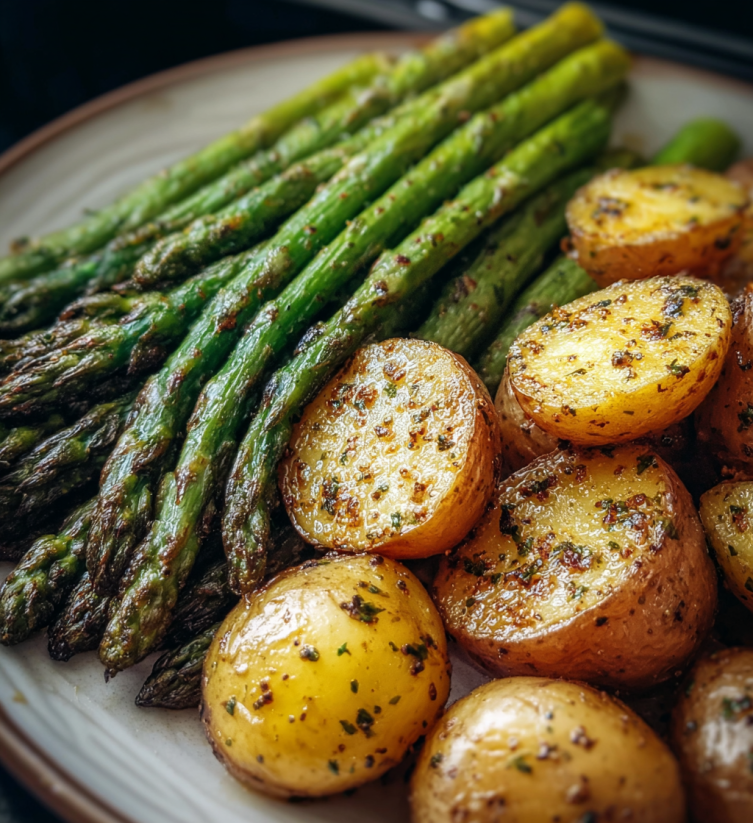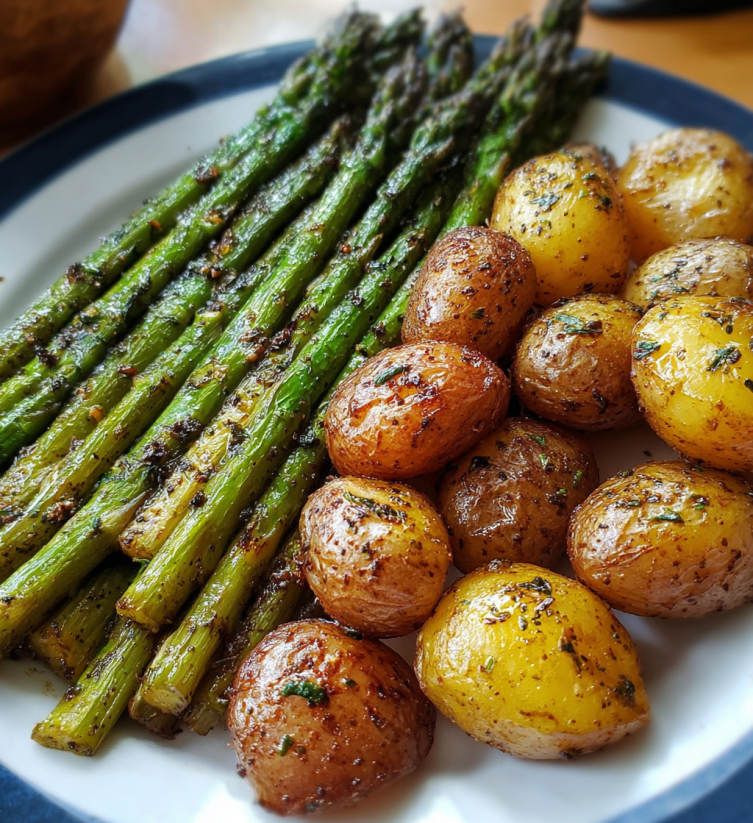 Save
Save
Roasted asparagus and potatoes have a permanent spot on my dinner table because they are the ultimate blend of simplicity and flavor. Whenever I need something healthy and low-fuss that still feels special, this dish rises to the occasion. It is my favorite answer to hectic weeknights or when guests show up unannounced. The golden tenderness of potatoes and the bright crisp of asparagus are just irresistible together. After trying it once during a busy workweek, my family now begs for it—no leftovers ever make it to lunch the next day.
I first made this when rushing home one evening and could not believe how fast and full of flavor it was. It remains a favorite because everyone looks forward to the bright colors and the aroma that fills the kitchen.
Ingredients
- Asparagus: Look for firm stalks with closed tips preferably medium-thick for the best texture and flavor Adds a fresh snap and a slight earthiness
- Baby potatoes: Choose small, thin-skinned potatoes like Yukon Gold for a buttery bite and the cutest presentation Tender and soaks up all the tasty seasonings
- Olive oil: Use high-quality extra virgin olive oil for maximum richness and to help everything crisp up in the oven Gives a lovely golden exterior
- Garlic powder: This easy pantry item delivers savory warmth and depth to every bite Try to pick a fresh bottle for the boldest taste
- Salt: Opt for fine sea salt for even distribution Seasons all the veggies and brings out their natural sweetness
- Black pepper: Freshly cracked is ideal for a punchy bite and aroma Adds just the right amount of heat
Step-by-Step Instructions
- Preheat the Oven:
- Get your oven nice and hot at 425 degrees Fahrenheit or 220 degrees Celsius Letting it fully warm up ensures the veggies will start roasting immediately and get that beautiful caramelized color
- Prepare the Vegetables:
- Trim the woody ends off the asparagus and cut each stalk in half Grab the baby potatoes and slice each one in half so they cook evenly Combine both in a big bowl so there is lots of room to toss
- Season Everything:
- Drizzle olive oil generously over asparagus and potatoes Sprinkle with garlic powder then season all over with salt and black pepper Use your hands or a spatula to toss everything together until every piece looks glossy and well coated This step sets the foundation for an even roast
- Arrange on Baking Sheet:
- Spread the seasoned veggies out on a large baking sheet Try to keep them in a single layer If they are crowded they will steam instead of crisping up Use parchment paper for easy cleanup if you like
- Roast to Perfection:
- Roast in the preheated oven for 25 to 30 minutes Give things a good stir halfway through roasting This helps both the asparagus and potatoes brown on all sides and cook evenly Bake until the potatoes are fork tender and the asparagus is crispy on the tips
- Check for Doneness:
- Test the potatoes by piercing with a fork If it slides in easily they are ready Once done bring the tray straight to the table and serve while everything is hot and fragrant
 Save
Save
Asparagus is the star for me and reminds me of early spring when my grandmother used to bring bundles home from the market We would make this dish together for special Sunday meals and the kitchen always smelled incredible The tradition now continues with my own kids and we all get excited when asparagus comes into season
Storage tips
To keep leftovers fresh always allow roasted veggies to cool completely before transferring to a sealed glass or plastic container Store in the refrigerator and they will stay delicious for about three days If you want to freeze them for later lay them out first on a baking sheet until solid and then transfer to a freezer bag They reheat best in the oven or toaster oven to maintain that signature crispy edge Microwaving works in a pinch for speed but expect a softer texture
Ingredient substitutions
No asparagus on hand Broccoli florets or green beans also roast up beautifully in this recipe If you are out of baby potatoes chop any waxy potato into bite sized pieces and they will cook up just as well For more flavor feel free to add a dusting of smoked paprika or swap the olive oil with avocado oil for a neutral base that handles high heat
 Save
Save
Serving suggestions
This side goes with just about everything Try it alongside grilled chicken or salmon for a simple weeknight plate or pair it with a vegetarian main such as a chickpea salad Even better toss the roasted veggies with cooked pasta for an easy primavera dinner and top with a generous sprinkle of parmesan cheese
Cultural and historical context
Roasting vegetables is a timeless method used to bring out their sweetness and create layers of texture and taste Dishes like roasted potatoes have roots in many European kitchens while asparagus is celebrated across the Mediterranean for its short but abundant spring harvest Bringing them together creates a meal that feels both modern and deeply comforting
Common Recipe Questions
- → How do I keep asparagus and potatoes crisp while roasting?
Spread vegetables in a single layer on the baking sheet, avoiding overcrowding. This allows them to roast rather than steam and helps them brown and crisp up beautifully.
- → Which herbs pair well with roasted asparagus and potatoes?
Fresh or dried thyme, rosemary, and Italian seasoning bring extra depth. Adding a sprinkle before roasting or tossing with fresh herbs after baking enhances flavor.
- → Can I add other vegetables to the mix?
Absolutely! Bell peppers, carrots, or red onions make great additions. Just be mindful of the different roasting times and cut all veggies to similar sizes.
- → What main dishes go well with this side?
Roasted asparagus and potatoes complement grilled chicken, seared salmon, pork tenderloin, or vegetarian mains like lentil patties or pasta primavera.
- → How do I store and reheat leftovers?
Cool completely, store in an airtight container in the fridge for up to three days. Reheat in the oven at 400°F for best results, or microwave for convenience.
- → Can I freeze roasted asparagus and potatoes?
Yes, freeze cooled vegetables in a single layer first, then transfer to a freezer bag. Best enjoyed within two months; texture may change slightly after thawing.
